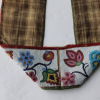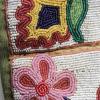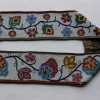Bandolier bag
Bandolier bag
Bandolier bag




















Pouch panel with two-piece shoulder strap, overlaid spot stitch appliqué floral beading, tabs with geometric designs.
Based on catalogue records
Summary of catalogue records.
Read More About This Relative
Cotton muslin, seed beads, twill tape, wool, thread.
Bandolier has two-piece shoulder strap, and a pouch panel of cotton muslin with brown cloth backing, 12 cm panel above pouch, Strap is cotton muslin with brown checked cloth backing, Outer edge of strap and pouch have red twill tape border which forms tabs at bottom corners, Inner strap edge has a green twill tape border, Green cloth border on pocket opening, Overlaid spot stitch appliqué floral beading, Nine loom woven beaded tabs attached to panel bottom to form fringe.
Motifs and Images: Front of pouch and strap decorated with broad, beaded symmetrical floral designs in opaque white background and navy blue bead double and triple stems, opaque and semi-translucent beads, Tabs have geometric designs of white, yellow, green, blue, navy opaque and semi-translucent beads with two red wool tassels on each tab.
Bandolier bags most likely originated in the Upper Great Lakes region during the 1840s and 1850s. Fashioned exclusively from European materials and adorned with thousands of beads, bandolier bags were primarily for show, as a symbol of identity, wealth and status. Although initially functional, by the late 19th and early 20th centuries many of the bags had false pouches or none at all. Sometimes called "friendship bags", they were often created as gifts to strengthen relationships within communities or between nations. By the 1870s they had become an important element of formal dress worn mainly at ceremonies and celebrations by men, and occasionally by women. They wore them - singly or several at a time - crossed over the torso or draped around the neck. The wearing of more than one bag was generally the prerogative of a leader or a person of high honour." (McCord, 2013). Bandolier adopted by Ojibwa in 19th century after seeing bullet pouches used by British soldiers. Bullet pouches were plain and decorated with crest or coat of arms. When idea adopted by Ojibwa, they were greatly prized and highly decorated ceremonial accessories. They became so highly prized by Ojibwa and other tribes (especially Sioux), that one bandolier could be traded for one pony. They became a status symbol of highest ranking Midewiwin priests.
From catalogue records.
Provenance
Hudson's Bay Company Winnipeg Fur Trade Department collected materials in preparation for 250th anniversary celebrations of the HBC in 1920. Many of these items were used in the Processions and Pow Wow at Lower Fort Garry in May, 1920.
The McCord Museum, 2013; Print.
Hudson's Bay Company Historical Exhibit
Opened June 19, 1922, in Winnipeg in the Portage Avenue "HBC" store.
About This GRASAC Record
Manitoba Museum













Northeast Great Lakes Riverine
 Knowledge Sharing Platform
Knowledge Sharing Platform



















